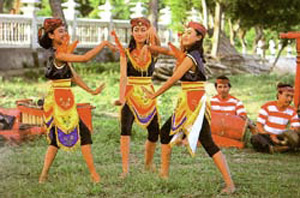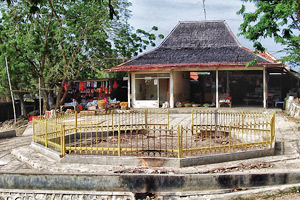On the whole, Madura is one of the poorest regions of the East Java province. Unlike Java, the soil is not fertile enough to make it a major agricultural producer. Limited other economic opportunities have led to chronic unemployment and poverty. These factors have lead to long-term emigration from the island, such that most ethnically Madurese people do not now live on Madura. People from Madura were some of the most numerous participants in government transmigration programs, moving to other parts of Indonesia.
Subsistence agriculture is a mainstay of the economy. Maize is a key subsistence crop, on island's many small landholdings. Cattle-raising is also a critical part of the agricultural economy, providing extra income to peasant farmer families, in addition to being the basis for Madura's famous bull-racing competitions. Small-scale fishing is also important to the subsistence economy.
Among export industries, tobacco farming is a major contributor to the island's economy. Madura's soil, while unable to support many food crops, helps make the island an important producer of tobacco and cloves for the domestic kretek (clove cigarette) industry. Since the Dutch era, the island has also been a major producer and exporter of salt.
Bangkalan, on the western end of the island, has industrialized substantially since the 1980s. This region is within a short ferry ride of Surabaya, Indonesia's second-largest city, and hence has gained a role as a suburb for commuters to Surabaya, and as a location for industry and services that need to be near the city. The long-planned Surabaya-Madura (Suramadu) Bridge now under construction, is expected to further increase the Bangkalan area's interaction with the regional economy.
 It’s a reflection of King Baladewa’s movement with strong character, stiff, open minded and straight in revealing every problem is identical Madurese character.
It’s a reflection of King Baladewa’s movement with strong character, stiff, open minded and straight in revealing every problem is identical Madurese character.  This tourism object is located at Larangan Tokol village, Tlanakan district, about 4 km of Pamekasan city. It’s very beautiful especially during the night. This place has a big sulphur spring and has many natural flame sources that often are beneficial for national sport events. It is a hilly area with beautiful scenery and surrounded by a fertile fruit producing area.
This tourism object is located at Larangan Tokol village, Tlanakan district, about 4 km of Pamekasan city. It’s very beautiful especially during the night. This place has a big sulphur spring and has many natural flame sources that often are beneficial for national sport events. It is a hilly area with beautiful scenery and surrounded by a fertile fruit producing area.

